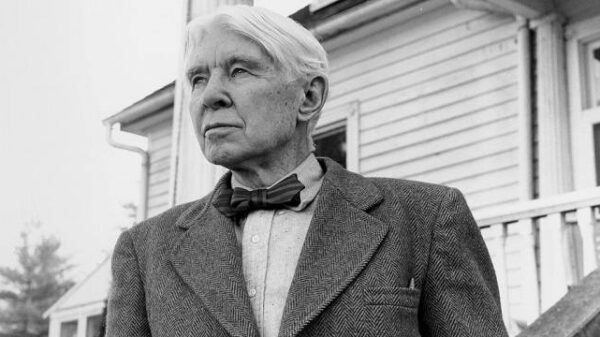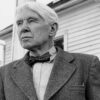This Crossing The Bar commentary will entirely help you better understand, love and appreciate this amazing piece of art.
Crossing The Bar continues to remain one of Alfred, Lord Tennyson’s famous poems in history. It has been accepted, accoladed and eulogized by both ancient and modern writers of poetry. Check the commentary, structure and summary below;
Crossing The Bar(Read Poem Below)
Crossing The Bar a Poem By Alfred, Lord Tennyson
Summary
The speaker in the poem ‘Crossing The Bar‘ heralds the setting of the sun and the rise of the evening star, and hears that he is being called. He hopes that the ocean will not make the mournful sound of waves beating against a sand bar when he sets out to sea. Rather, he wishes for a ripple that is so full that it cannot contain sound or foam and therefore seems asleep when all that has been carried from the boundless chasms of the ocean returns back out to the depths.
The speaker declares the climax of the day and the evening bell, which will be heeded by darkness. He hopes that no one will weep when he departs, because although he may be carried beyond the limits of time and space as we know them, he retains the hope that he will look upon the face of his “Pilot” when he has stricken out the sand bar.
Structure – Crossing The Bar
This poem consists of 4 quatrain stanzas with ABAB rhyme scheme. The 1st and 3rd lines of each stanza are always a couple of beats longer than the 2nd and 4th lines, although the line lengths vary among the stanzas.
Read Also: Antichrist, or the Reunion of Christendom: an Ode By G.K. Chesterton
Crossing The Bar Commentary
This Crossing The Bar commentary will give you a general overview of what the poem means in its simplest way.
One of the world’s greatest writers, Alfred, Lord Tennyson birthed “Crossing the Bar” in 1889, that’s three years before he kicked the bucket. Crossing The Bar describes his placid and accepting human behaviour toward death. Although he followed this work with ensuing poems, he asked that “Crossing the Bar” appear as the final poem in all collections of his work.
Alfred, Lord Tennyson uses the metaphor of a sand bar to describe the impediment that exists between life and death. A sandbar is a ridge of sand built up by currents along a shore. In order to reach the shore, the waves must crash against the sandbar, creating a sound that the writer describes as the “moaning of the bar.” The bar is one of several images of liminality in the poetry piece: in “Ulysses,” the hero desires “to sail beyond the sunset”; in “Tithonus”, the main character finds himself at the “quiet limit of the world,” and regrets that he has asked to “pass beyond the goal of ordinance.”
The other prominent image in the poem is one of “crossing,” suggesting Christian connotations: “crossing” refers both to “crossing over” into the next world, and to the act of “crossing” oneself in the classic Catholic movement of religious faith and devotion. The religious implication of crossing was plainly familiar to Alfred Tennyson’s, for in an earlier poem of his, the knights and lords of Camelot “crossed themselves for fear” when they saw the Lady of Shalott lying dead in her boat. The cross was also where Jesus died; now as Tennyson himself dies, he evokes the image again. So, too, does he hope to complement this metaphorical link with an ethical one: he hopes that he will “see [his] Pilot face to face.”
The rhyme scheme ABAB of ‘Crossing The Bar’ echoes the stanzas’ thematic patterning: the 1st and 3rd stanzas are linked to one another as are the 2nd and 4th. Both the 1st and 3rd stanzas begin with two symbols of the onset of night: “sunset and evening star” and “twilight and evening bell.” The 2nd line of each of these stanzas begins with “and,” conjoining another item that does not fit together as straightforwardly as the first two: “one clear call for me” and “after that the dark!” Each of these lines is followed by an exclamation point, as the poet expresses alarm at realizing what death will entail. These stanzas then conclude with a wish that is stated metaphorically in the first stanza: “may there be no moaning of the bar / When I put out to sea”; and more literally in the third stanza: “And may there be no sadness of farewell / When I embark.” Yet the wish is the same in both stanzas: the poet does not want his relatives and friends to cry for him after he dies. Neither of these stanzas concludes with a period, suggesting that each is intimately linked to the one that follows.
Read Also: Ulysses a Poem By Alfred, Lord Tennyson
The 2nd and 4th stanzas are linked because they both begin with a qualifier: “but” in the second stanza, and “for though” in the fourth. In addition, the second lines of both stanzas connote excess, whether it be a tide “too full for sound and foam” or the “far” length that the poet will be hauled in death.
Credits: sparknotest
Poet Nazir is a writer and an editor here on ThePoetsHub. Outside this space, he works as a poet, screenwriter, author, relationship adviser and a reader. He is also the founder & lead director of PNSP Studios, a film production firm.










